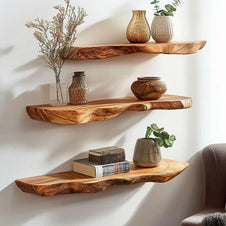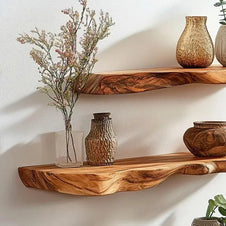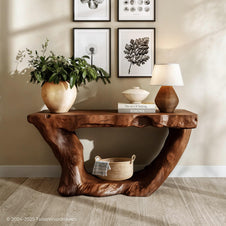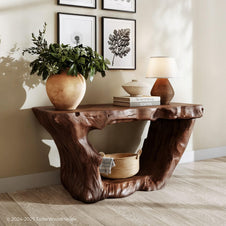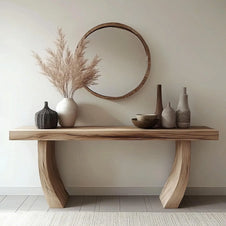There’s something magical about combining two smart interior ideas: corner optimization and nature-inspired design. A corner tree bookshelf DIY gives you both. It’s not only space-saving and practical—it’s personal, artistic, and downright charming. Whether you’re working with a narrow hallway, unused nook, or a cozy reading corner, this project lets you reclaim space while making something that looks sculptural and intentional.
In this guide, we’ll walk you through every part of a corner tree bookshelf DIY project. Whether you're a first-timer with basic tools or a seasoned woodworker looking for a weekend challenge, this is your comprehensive plan.
1. Visualizing Your Corner Tree Bookshelf DIY
Before you pick up a saw or sketch plans, start with a clear vision. Consider the following:
-
Will it be floating or freestanding?
-
How tall should the trunk be?
-
How many branches (shelves) do you want?
-
What kind of wood tone or paint finish suits your room?
-
Will it be symmetrical or natural/irregular?
A good corner tree bookshelf DIY starts with a strong mental picture and visual references. Pinterest, Etsy, or interior design blogs are great for inspiration.
Sketch multiple drafts on graph paper. Add exact wall measurements and ceiling height. Consider whether your bookshelf will face natural light—important if you're storing plants or paperbacks sensitive to sunlight.
It helps to create a mood board with tones, finishes, and furniture that will share the space with your future shelf. Remember: the most successful corner tree bookshelf DIY builds don't just fit—they harmonize with their environment.
Include lifestyle needs in your vision. Will the shelf hold books, toys, decor, or planters? Will it act as a focal point or blend quietly with the wall? Defining the role of your shelf guides every choice from shape to material.
2. Materials You’ll Need for Your Corner Tree Bookshelf DIY
Here’s a basic list:
-
Wood planks (¾" thick is standard): for trunk and branches
-
Screws and wall anchors: for mounting
-
Wood glue and clamps
-
Sandpaper or an electric sander
-
Saw (hand saw, jigsaw, or circular saw)
-
Stud finder and level
-
Paint or stain and brush/sealer
-
Drill with bits for pilot holes and countersinks
Choosing the right wood is essential for a lasting corner tree bookshelf DIY.
For a rustic look, reclaimed wood like barnwood or pallet boards adds natural character. For a clean Scandinavian finish, use birch or maple. Walnut or oak offers strength and rich tones.
Consider environmental factors too—humidity levels in your space may affect how some woods expand or contract. If you're staining, test the finish on a scrap piece first.
Don't forget safety gear: goggles, gloves, and a dust mask for sanding.
 You may also want accessories like wood filler, anti-tip brackets for child safety, and rubber bumpers to protect adjacent walls. Depending on your design, LED strip lights or metal shelf rods could add extra polish to your corner tree bookshelf DIY masterpiece.
You may also want accessories like wood filler, anti-tip brackets for child safety, and rubber bumpers to protect adjacent walls. Depending on your design, LED strip lights or metal shelf rods could add extra polish to your corner tree bookshelf DIY masterpiece.
3. Measuring Your Corner
Measure both walls forming the corner and decide how far each branch should extend. Typical guidelines:
-
Branch depth: 6–10 inches
-
Trunk height: 60–72 inches
-
Vertical spacing between branches: 10–14 inches
Tip: Tape out the trunk and shelves on the wall using painter’s tape to visualize your design. This visual mock-up prevents common mistakes like misalignment, uneven heights, or overcrowding.
Double-check for baseboard thickness—some corners have quarter-round molding or angled skirting that can throw off flush mounting. Measuring from multiple heights along each wall can reveal if they’re not perfectly plumb (which is common in older homes).
If you’re building a tall tree bookshelf, factor in stability: corners close to doorways or windows may have more draft or foot traffic. In these cases, wall anchoring becomes even more critical.
Print out scaled templates of shelf levels or branch positions and tape them to the wall to test composition. It’s better to spot a visual imbalance now than after you’ve drilled.
 Sketch a side view and top-down plan to align with furniture around it (sofas, desks, etc.). Use a laser level for accuracy—this can make a huge difference in the quality of your finished corner tree bookshelf DIY project.
Sketch a side view and top-down plan to align with furniture around it (sofas, desks, etc.). Use a laser level for accuracy—this can make a huge difference in the quality of your finished corner tree bookshelf DIY project.
4. Cutting the Trunk and Branches
Cut your main trunk piece—this anchors the visual tree. Use a jigsaw for natural curves or keep it rectangular for a stylized trunk. Branches can be:
Label each piece as you go. In any corner tree bookshelf DIY, labeling helps prevent confusion during assembly.
You can also bevel or round the edges for a softer look. This small detail gives a handcrafted feel and reduces chances of injury.
For a branching effect, angle cuts on the back of each shelf so they nest into the corner more tightly. Pre-drill pilot holes to prevent wood splitting.
If you’re unsure about freehand curves for the trunk, use a large compass or create a paper stencil. You can also mix shelf styles—have two straight arms and one curved—depending on how organic or geometric you want your design to feel.
Keep in mind, longer branches should taper slightly at the tip for a more natural look. Use a chisel or rasp to carve in bark-like texture if you’re going for a highly stylized nature vibe.
 When all pieces are cut, lay them out on the floor in your planned configuration and photograph it. This serves as a visual guide when you start mounting and assembling the full corner tree bookshelf DIY structure.
When all pieces are cut, lay them out on the floor in your planned configuration and photograph it. This serves as a visual guide when you start mounting and assembling the full corner tree bookshelf DIY structure.
5. Sanding and Finishing
Before you install, sand all edges smooth. This isn’t just for looks—it’s a safety measure, especially in homes with kids. Once smoothed:
-
Apply wood conditioner (if staining)
-
Stain or paint your pieces
-
Finish with a clear sealant for longevity
Use a fine 220-grit paper for finishing touches. For painted shelves, use primer and two coats of semi-gloss for durability.
This step elevates your corner tree bookshelf DIY from craft to furniture-grade design. Want a weathered effect? Try dry-brushing or whitewashing techniques.
Use painter’s pyramids or scrap blocks to elevate pieces off your workbench during painting or staining—it helps you reach all edges and prevents drips from pooling. If your tree bookshelf will be placed near a sunny corner, consider using a UV-protective finish to prevent yellowing or fading.
You might also want to mix finishes: paint the trunk a matte charcoal, for example, and stain the branches in warm walnut to add visual contrast. This technique enhances the "tree" illusion while adding modern depth to your corner tree bookshelf DIY.

For a whimsical touch, you can stencil leaves, birds, or even a quote along the trunk before sealing corner tree bookshelf.
6. Assembly: Putting It All Together
Layout your trunk and attach branches using wood glue and screws. Use clamps to hold branches in place while drilling. If you're going for floating brackets, insert those into the branch undersides.
Dry-fit the whole thing on the ground first, then mount.
If your branches are longer than 18 inches, consider adding small triangular braces or hidden dowels for added support. Let glue cure overnight for max strength.
Create a central guide line along the trunk to ensure branches stay level and don’t drift off-angle as you build upward. This ensures the overall corner tree bookshelf DIY looks intentional—not chaotic.
7. Installing With Confidence
Once your corner tree bookshelf DIY is fully assembled and ready to mount, take time to ensure your installation is solid and precise. Position the trunk flush into the corner and confirm level alignment on both walls using a laser or bubble level.
Use at least two screws per stud for the trunk section. If studs aren’t aligned with your shelf layout, supplement with heavy-duty drywall anchors rated for at least 50 lbs. Be sure to use washers with your screws to prevent them from slipping through the wood.
For shelves longer than 20 inches, consider mounting a hidden bracket inside the trunk or adding side brackets for lateral support. If your bookshelf is tall or narrow, use anti-tip hardware connected to the wall near the top.
After securing your frame, give each shelf a gentle shake to test for movement. Fix any wobbles before decorating. Once installed, your corner tree bookshelf DIY should feel as sturdy as any store-bought alternative—but carry the pride of something handmade.
Don’t forget to wipe the surface with a clean cloth to remove dust, and give it 24 hours before loading with heavy books or decor.
Conclusion: A Tree Grows in Your Corner
Crafting your own corner tree bookshelf DIY is more than just a weekend project—it’s an invitation to bring beauty, creativity, and personality into your home. You’re not just making storage; you’re growing a story on your wall.
By following thoughtful measurements, using quality materials, and allowing yourself room for creative expression, your DIY shelf will outlast trends and reflect your unique taste.
Whether you're a seasoned builder or first-time DIYer, there’s pride in seeing your vision take shape—branch by branch. So go ahead: sketch it out, pick your wood, and let that blank corner bloom into something extraordinary.

